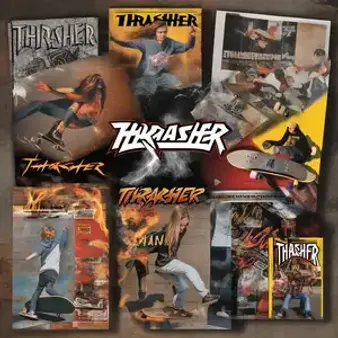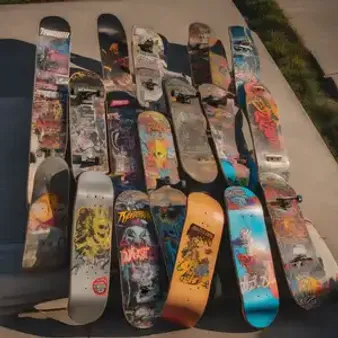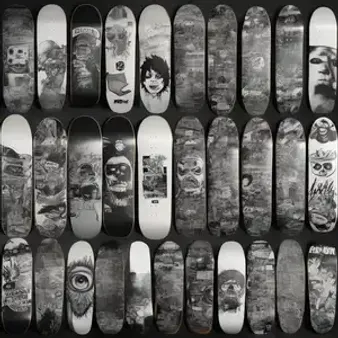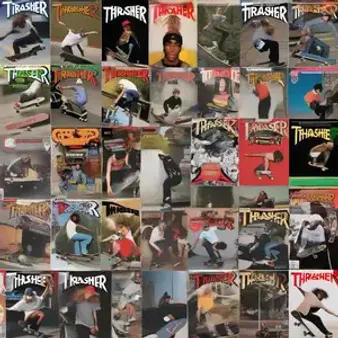Table of Contents
Thrasher Magazine, the rebellious bible of skateboarding, has become synonymous with a raw and authentic aesthetic. A huge part of that identity comes from their iconic covers, which have documented the evolution of skateboarding for decades. kizworld takes you on a journey through the history, art, and cultural significance of thrasher covers, showcasing how these bold images have captured the spirit of skateboarding and influenced generations of skaters and artists.
Aspect | Details |
|---|---|
History | Thrasher covers have evolved alongside skateboarding, reflecting the sport's progression and cultural shifts. |
Impact | Iconic covers have cemented Thrasher's status as a skateboarding authority and influenced fashion, music, and art. |
Artists | Talented photographers and illustrators have contributed to Thrasher's unique visual identity. |
Collecting | Thrasher covers are sought-after collectibles, reflecting their historical and artistic value. |
The History and Evolution of Thrasher Covers
Thrasher Magazine hit the scene in 1981, a time when skateboarding was exploding in popularity but still felt like an outsider's world. The magazine's founders, Kevin Thatcher, Eric Swenson, and Fausto Vitello, wanted to create a publication that truly captured the raw energy and rebellious spirit of skateboarding. They weren't interested in glossy photoshoots or corporate sponsorships; they wanted grit, authenticity, and a whole lot of attitude. And that's exactly what they achieved with Thrasher covers. Early covers featured grainy photos of skaters pulling off gnarly tricks, often shot in gritty urban environments. There was a sense of danger and rebellion in those images, a feeling that these skaters were pushing boundaries and defying expectations. It was like a secret handshake, a way for skaters to recognize each other and say, "We're not like everyone else."
As skateboarding evolved, so did Thrasher covers. The 1980s saw the rise of vert skating, with skaters like Tony Hawk pushing the limits of aerial acrobatics. Thrasher covers reflected this shift, showcasing skaters soaring through the air in massive halfpipes. But Thrasher never lost sight of its street roots. Even as skateboarding became more mainstream, the magazine continued to feature raw and edgy photography, capturing the rebellious spirit that had always defined the sport. In the 1990s, as street skating dominated the scene, Thrasher covers showcased the technical prowess and creativity of skaters like Chad Muska and Jamie Thomas, grinding down handrails and pulling off mind-bending tricks in urban landscapes. It was a visual chronicle of skateboarding's evolution, a testament to the sport's constant innovation and unwavering rebellious streak.
Through the 2000s and beyond, Thrasher covers continued to evolve, embracing new styles of photography and graphic design. They've featured everything from gritty black-and-white photos to vibrant illustrations, always staying true to the magazine's rebellious spirit. Thrasher covers have become iconic, instantly recognizable symbols of skateboarding culture. They've graced everything from T-shirts and hoodies to skateboards and even tattoos, serving as badges of honor for skaters and fans alike. And it all started with a simple desire to capture the raw energy and rebellious spirit of skateboarding, a mission that continues to drive Thrasher Magazine and its iconic covers today. It's like looking at vintage Tony Hawk's moves and seeing how the sport has transformed.
Decade | Dominant Skateboarding Style | Thrasher Cover Aesthetic |
|---|---|---|
1980s | Vert Skating | Grainy photos, gritty urban environments, sense of danger and rebellion |
1990s | Street Skating | Raw and edgy photography, technical prowess, urban landscapes |
2000s-Present | Varied Styles | Gritty black-and-white photos, vibrant illustrations, rebellious spirit |
The History and Evolution of Thrasher Covers
Iconic Thrasher Covers and Their Impact
Covers That Defined a Generation
Some Thrasher covers are so iconic, they've become part of skateboarding's DNA. Take the July 1987 cover featuring Mark Gonzales doing a "melon grab" over a chain-link fence. It's a shot that screams rebellion and freedom, perfectly capturing the spirit of street skating. The photo, taken by legendary skate photographer Mofo, became instantly iconic, cementing Gonz's status as a skateboarding legend and showcasing Thrasher's knack for capturing raw, unfiltered moments. This cover wasn't just about the trick; it was about the attitude, the energy, and the feeling of pushing boundaries that resonated with skaters everywhere. It's like that feeling you get when you finally nail a new trick on your skate ramp; it's pure joy and accomplishment.
Another classic is the February 1989 cover with Tony Hawk soaring through the air in a massive halfpipe. This cover came at a time when vert skating was exploding, and Hawk was leading the charge with his incredible aerial maneuvers. The photo, by Grant Brittain, captured the sheer power and athleticism of vert skating, showing the world that skateboarding was more than just street tricks. It was a sport with its own stars, its own challenges, and its own sense of awe-inspiring spectacle. This cover, like many others, helped Thrasher transcend the world of skateboarding, influencing fashion, music, and art with its bold imagery and rebellious attitude. It's like how listening to music can pump you up before you hit the vert; it sets the mood and gets you ready to shred.
The Legacy of Thrasher Cover Art
Thrasher covers have become more than just magazine art; they're cultural artifacts that reflect the evolution of skateboarding and its impact on the world. They've inspired countless artists, photographers, and designers, and their influence can be seen in everything from street wear to contemporary art. The bold graphics, raw photography, and rebellious spirit of Thrasher covers have become synonymous with skateboarding culture, serving as a visual shorthand for the sport's energy, creativity, and nonconformist attitude. It's like how a Louie Lopez video can inspire you to try new tricks; it's all about pushing boundaries and expressing yourself.
What makes Thrasher covers so special is their ability to capture the essence of skateboarding in a single image. They're not just about the tricks; they're about the attitude, the style, and the raw energy that makes skateboarding so unique. They're a celebration of individuality, creativity, and the pursuit of freedom on four wheels. And that's something that resonates with people far beyond the world of skateboarding, making Thrasher covers a powerful and enduring form of visual expression. It's like how wearing your favorite skateboard backpack makes you feel part of something bigger; it's a symbol of belonging and shared passion.
Iconic Thrasher Cover | Year | Photographer | Impact |
|---|---|---|---|
Mark Gonzales Melon Grab | 1987 | Mofo | Captured the spirit of street skating, cemented Gonz's legacy |
Tony Hawk Halfpipe Air | 1989 | Grant Brittain | Showcased the power of vert skating, expanded Thrasher's influence |
Iconic Thrasher Covers and Their Impact
The Artists Behind Thrasher Magazine Covers
Capturing the Spirit of Skateboarding
Thrasher covers aren't just about awesome photos of skaters pulling off sick tricks. They're about capturing the soul of skateboarding, that raw energy and rebellious spirit that makes it so unique. And behind those iconic images are some seriously talented artists, photographers, and illustrators who've helped shape Thrasher's visual identity. Think of it like this: if skateboarding was a band, these artists would be the ones creating the album covers that perfectly capture their sound and attitude.
Guys like Mofo, Grant Brittain, and Bryce Kanights have become legends in the skateboarding world for their ability to capture those epic moments that define the sport. They don't just take pictures; they tell stories with their lenses, freezing those moments of pure adrenaline and style that make you want to grab your board and hit the streets. Their work has inspired countless skaters and artists, and their photos have become synonymous with the Thrasher brand.
- Mofo
- Grant Brittain
- Bryce Kanights
More Than Just Photography
But Thrasher covers aren't just about photography. Over the years, they've featured all sorts of awesome artwork, from gritty black-and-white illustrations to vibrant, eye-popping graphics. Artists like Sean Cliver, Michael Sieben, and Mark McKee have brought their own unique styles to Thrasher covers, pushing the boundaries of what a skateboarding magazine cover could be. It's like they took the energy of a kickflip and turned it into art.
These artists have helped Thrasher stay fresh and relevant, always pushing the envelope and reflecting the ever-evolving world of skateboarding. Their work has become highly collectible, with original Thrasher cover art fetching hefty prices at auctions and galleries. It just goes to show that Thrasher covers aren't just magazine art; they're pieces of skateboarding history, snapshots of a culture that continues to inspire and defy expectations.
Artist | Style |
|---|---|
Sean Cliver | Gritty black-and-white illustrations |
Michael Sieben | Vibrant, eye-popping graphics |
Mark McKee | Unique illustrative style |
The Artists Behind Thrasher Magazine Covers
Collecting and Appreciating Thrasher Covers
From Magazine Rack to Collector's Item
Thrasher covers are like mini pieces of skateboarding history. They've documented the sport's evolution, showcased amazing photography and art, and captured the rebellious spirit that makes skateboarding so unique. So it's no surprise that people love collecting them! Some folks frame them and hang them on their walls, turning their homes into mini skateboarding museums. Others keep them in pristine condition, carefully stored away in protective sleeves, treating them like valuable artifacts. Imagine having a cover from the 80s with Tony Hawk soaring through the air – that's like owning a piece of skateboarding legend!
Collecting Thrasher covers is a cool way to show your love for skateboarding and its history. You can find them at flea markets, online auctions, and even specialty stores that cater to skateboarding enthusiasts. It's like a treasure hunt, searching for those rare and iconic covers that tell a story. Plus, it's a great conversation starter! Imagine having friends over and they spot that classic Gonz melon grab cover on your wall – instant skateboarding cred! You can learn how to improve your coordination from skateboarding.
Place to find Thrasher covers |
|---|
Flea markets |
Online auctions |
Specialty stores |
The Value of a Thrasher Cover
Now, some Thrasher covers are worth serious money, especially those from the early days of the magazine or featuring iconic skaters and artists. It's like collecting baseball cards – some are more valuable than others depending on their rarity and historical significance. So if you stumble upon a first edition Thrasher with a cover shot by Mofo, you might be sitting on a goldmine! But even if your Thrasher covers aren't worth a fortune, they're still valuable to you as a fan. It's about the memories they evoke, the stories they tell, and the connection they represent to a culture you love.
Collecting Thrasher covers is about more than just owning stuff; it's about appreciating the art, the history, and the spirit of skateboarding. It's like having a time capsule that takes you back to the days when skateboarding was all about pushing boundaries, defying expectations, and expressing yourself on four wheels. And that's something worth cherishing, whether it's a cover featuring Tony Hawk's legendary vert skills or a gritty street shot by Grant Brittain. It's a reminder that skateboarding is more than just a sport; it's a way of life.
- WKND Skateboards
- New Balance SB
- Surf Skateboard
Collecting and Appreciating Thrasher Covers
Final Thought
Thrasher covers are more than just magazine art; they are snapshots of skateboarding history, windows into the soul of a subculture, and a testament to the enduring power of creative expression. Whether you're a seasoned skater, an art enthusiast, or simply appreciate bold visuals, exploring the world of Thrasher covers offers a fascinating glimpse into a culture that continues to defy convention and inspire creativity.